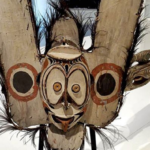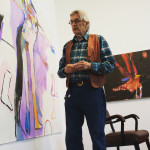by Haylee Kushi (Staff Writer)
The Yale Peabody Museum is celebrating its 150th anniversary with the installment of the exhibition: “Identity, Difference, and Understanding: Lessons from Oceania and Southeast Asia” at the PEABODY2, a one-room museum on the corner of York and Elm, a space offered to the Peabody Museum by Yale’s Office of New Haven and State Affairs in recognition of the Peabody’s sesquicentennial anniversary. “Our hope is that by having this gallery more in the heart of campus, students will be more inclined to stop in and visit the exhibition and gain a greater understanding of the nature and depth of our collection,” said David Heiser, Director of Student Programs at the Peabody. The museum displays pieces of its anthropological collections, most of which have never been displayed publicly, from Southeast Asia and from what the museum defines as Oceania. The collections are divided regionally, with exhibits on Australia, Indonesia, New Guinea, and the Philippines.
A banner at the exhibit’s entrance reads “study of these dimensions of the materiality of human culture can offer new insights into the most fundamental questions about how we think about ‘others’ and, therefore, about ourselves.” The museum’s introductory text and many labels were written by Yale professor of anthropology Michael Dove, according to Heiser. Heiser also said that the museum provides “an opportunity to bring out some really large objects that we don’t usually have room to display very well at the Peabody,” which only represents 0.04 percent of the museum’s full collection.
While the museum then defines peoples from Southeast Asia and Oceania as “others,” it also lists Yale students from the Filipino Student Association, Malaysian Student Association, Southeast Asian Student Association, and Thai Student Association as a Student Advisory Committee. Organizations involved in the Student Advisory Committee will set up events to attract the Yale student community to the museum.
The students on the Advisory Committee will serve as liaisons between the Peabody2 and the Yale student community. “I really love the idea of the museum because of two main points,” said Sandy Wongwaiwate, a member of the Alliance for Southeast Asian Students (ALLSEA), “One is that we are able to give the student body more exposure to Southeast Asian culture and art. Two, we can use the space to encourage discussion about exploring how the art pieces connect with the history of Southeast Asia.”
“In none of the societies represented here has sacred art been produced for outsiders,” reads a panel on ethnographic art. The passage explains that Aboriginal Australian artists have problematized a preference for “sacred” art over art produced for outsiders, since global trade and intentionality in producing different art for outsiders can be a way of educating. The desire to educate through the production of “tourist art” comes through in the Australian exhibit in the pairing of Clifford Possum Tjapaltjarri’s acrylic painting Wallaby Dreaming (1988) and Bobby Bardjarray Nganjmirra’s Mimis and Namarodo Spirits with Kangaroo (1985). Aboriginal artists translated sacred, cultural, religious, or complex ideas into simple and secular representation for outsider audiences. The translated representation takes two different forms, dotting in acrylic on canvas and crosshatching in natural pigments on bark.
Both Wallaby Dreaming and Mimis and Namarodo Spirits with Kangaroo represent spirits in conversation, the first in conflict and the latter in collaboration. Both paintings also represent animal totems, which Aboriginal peoples are not allowed to hunt or eat. These meanings, however, are not apparent to an outsider. I only learned the cultural meanings of the dotting and crosshatching patterns after reading the informational panel. I did, however, see the animal footprints in Tjapaltjarri’s painting and the kangaroo in Nganjmirra’s. Perhaps this is all that outsiders are meant to understand.

The Papuan exhibit forces its audience to rethink the Western conception of what a mask is and how a mask should be used. The masks in the Papuan exhibit, thick and heavy looking and lacking eyeholes, are not meant to be worn, but are inhabited by the spirits that they represent. The art in the Peabody2 also challenges the Western conception of what is considered art. The exhibit on the Philippines focused heavily on the agricultural life of the indigenous people, featuring a rice storage basket (ulbung), utility and harvesting knife (uwah), and a bundle (bentó) of unthreshed and unhusked rice. The art of the indigenous people of the Philippines, or Ifugao, also broke down the Eurocentric barriers between food and religion, between cultural practice and way of life, by including the bulul, or granary guardian figure, next to the agricultural tools.
The Peabody2 recognizes Yale’s history of wrongful acquisition and possession of artifacts. In an empty corner, a sign reads, “Machu Picchu: An Agreement Between Yale and Peru.” The sign goes on to explain that in 2012, Yale returned everything gathered from anthropologist Hiram Bingham III’s excavations of Machu Picchu to the people of Peru, where they now reside in the Machu Picchu Museum and the International Center for the Study of Machu Picchu and the Incan Culture. An advisory board drawn from both Yale and the University of Cuzco oversees the museum. “The history of Yale’s Machu Picchu collection is, like the objects in Peabody2, another example of how anthropological vision of peoples in distant time and space – and the conception of its own mission – has changed over the past century as the wider world has evolved,” reads the informational banner.
While the Peabody2 confronts a dark history of anthropology, the museum still presents the people of Oceania and Southeast Asia as “people in distant time and space.” Eugene Lim, a student in the Alliance for Southeast Asian Students and member of the Student Advisory Board, noticed a lack of contemporary Southeast Asian representation. Given that most Americans hold antiquated views of Southeast Asia, Lim explained, the museum does not challenge viewers’ conception of what Southeast Asians lived experiences are like today.
Lim also expressed hope that the museum could help give visitors a new perspective by hosting dynamic programming, like student events or guest speakers. If the museum were to bring speakers, though, Lim said that it would be “crucial to bring Southeast Asian speakers” to talk about Southeast Asia.
Although the pieces in the exhibit will probably not change, given that the pop-up museum will close down at the end of the academic year in May, student involvement and ongoing conversation about contemporary life in Southeast Asia, Oceania, and other regions represented in the museum are on the horizon for the Peabody2. “A major part of our mission is to be a resource to Yale students and faculty in every way we can – direct education, teaching support, research opportunities, student employment, and more,” said Heiser. “We hope students might see Peabody2 as a space where conversations about culture, race and identity that have been so prominent on campus over the last couple years can continue to take place.



